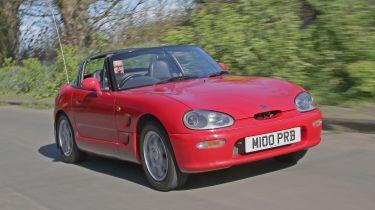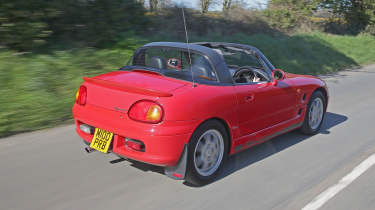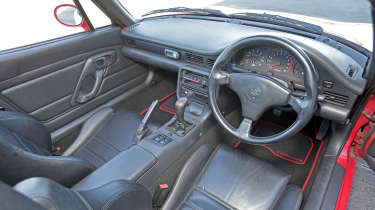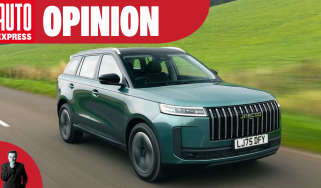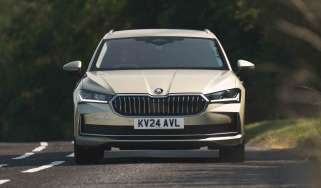Used Suzuki Cappuccino (1991-1997) buyer's guide: tiny kei car has big appeal
A full used buyer's guide on the Suzuki Cappuccino that was originally on sale between 1991 and 1997
Verdict
According to howmanyleft.co.uk, there are around 600 Cappuccinos remaining in the UK, most of which are on SORN. That figure needs to be taken with a pinch of salt because there are another 90,000 Suzukis on the database with no model assigned, but however you look at it, this is an unusual modern classic car. You probably wouldn’t want to buy a Cappuccino to run on an everyday basis, because it can be hard to keep rust at bay and parts availability can be a problem. But, as a fun second car, the Cappuccino is a great buy for occasional use, which is why we would suggest you find a good one, snap it up and just enjoy it.
As we head into the electric age, compact and affordable sports cars are a thing of the past for the new-car buyer. But when you’re buying used – and especially if you’re happy to explore the realms of the modern classic – there are a few gems that are worth seeking out.
One of them is the Suzuki Cappuccino, which hit UK shores more than three decades ago, before retreating to be largely forgotten. Created primarily for the Japanese market but officially imported to the UK for two years, the Cappuccino is cheap to run and great to drive, although it isn’t the most practical of cars. There are also a few things that you need to look out for when buying, so grab a coffee and we’ll tell you all about it.
History
In 1987 Suzuki started to work on a new two-seat sports car, but it would be another two years before an initial concept was shown at the Tokyo Motor Show. It was built to comply with Japan’s kei car rules, which restricted car size along with engine displacement and power; those regulations changed in 1990 to allow longer cars and engines of 660cc instead of 550cc.
Used - available now

2020 BMW
3 Series Touring
66,779 milesAutomaticDiesel2.0L
Cash £18,990
2022 Mercedes
EQA
50,730 milesAutomaticElectric
Cash £17,900
2023 Mercedes
A-Class
33,289 milesAutomaticPetrol1.3L
Cash £18,600
2020 Jaguar
F-Pace
35,782 milesAutomaticDiesel2.0L
Cash £20,200The Cappuccino entered production in 1991 and following a strong start in Japan, talks started with the UK importer about bringing the car here. Sure enough, at the 1992 London Motor Show, the Cappuccino made its debut.
The first cars were delivered in 1993, but just two years later the Cappuccino was withdrawn, because a revised car went into production in Japan and wasn’t type approved for Europe. These later models, sometimes imported to Europe individually, have a more muscular engine, the option of a three-speed auto, power steering, anti-lock brakes and a driver’s airbag. The final Cappuccinos were made in 1997, with the last cars sold in Japan in 1998.
Did you know you can sell your car through Auto Express? We’ll help you get a great price and find a great deal on a new car, too.
On the road
With just 63bhp on tap, the rear-wheel drive Cappuccino isn’t fast; it’s restricted to 83mph (as is the law for such cars in Japan) and takes 11.3 seconds to get to 60mph. But speed isn’t what this car is all about because it’s small – just 3.3 metres long – and light, at a mere 725kg. As such, it’s agile and enjoyable to drive, even at low speeds.
That three-cylinder engine just loves to be revved too; it’s red-lined at 8,500rpm but will go right up to 9,300rpm if pushed. With a slick five-speed gearbox, excellent weight distribution, well weighted steering and good brakes, the Cappuccino is a great driver’s car.
Which should I buy?
Only 1,110 examples of the UK-spec Cappuccino were sold in the UK between 1993 and 1995; 80 per cent were painted red and the rest were silver. But the car was available in Japan from 1991 until 1997 with a choice of 10 colours, and in total there were 28,010 Cappuccinos built.
As a result, quite a few of the cars now in the UK were originally sold in Japan, while Cappuccinos were also sold in Germany, France, Holland, Sweden, Hong Kong and New Zealand. All were right-hand drive. Some of the later cars from 1995 on have also now found their way here. At the very least, you should put any potential purchase through an MoT before buying, or ideally get it thoroughly inspected.
Alternatives to the Suzuki Cappuccino
The mid-engined Honda Beat is another kei car, with a 656cc engine, but this wasn’t brought to the UK officially and it’s rare here. Another mid-engined option is the 698cc Smart Roadster, which was current between 2003 and 2006. As such, it’s more modern than the Suzuki and easier to find, but running costs can be high because parts are expensive.
The Daihatsu Copen (2003-2009) is another kei car that was sold in the UK officially. This one has an electrically retractable hard top – but watch out for rot. The Mazda MX-5 is another model to shortlist, because it’s much more readily available, great fun to drive and even relatively practical.
What to look for
Rust in peace
The Cappuccino was poorly rustproofed, so corrosion is common. Look for rot in the floorpans, sills and wheelarches, although it’s often hidden by the plastic lower panels, which are purely cosmetic.
Panel work
The roof panels, boot lid and bonnet are made of aluminium, which keeps the weight down, but they get dented easily. Replacements are hard to find and when they do crop up, they’re expensive.
All the gears?
Most Cappuccinos (including all UK-supplied cars) come with a five-speed manual gearbox. The synchromesh wears, especially on second gear, so see if it crunches as you swap cogs. Repairs are expensive.
Belt up
Pre-facelift Cappuccinos had a cambelt that should be replaced every five years or 60,000 miles. Later cars had a chain-driven cam, so no belt. Engines and turbochargers are durable.
Interior
The dash may be dated, but it’s easy to get on with, and everything you need is there. This is also a brilliantly adaptable car, because it easily converts between fully open and fully closed, or there’s a half-way targa-style option. But it’s strictly a two-seater, and the boot is small; it’s only just big enough to stow the removable roof panels.
Prices
There is rarely a significant number of Cappuccinos for sale at any given time, so you’re unlikely to be spoiled for choice, while there are also a few in Japan, offered by specialist import companies.
Assuming you buy a car that’s already registered in the UK, you might bag a bargain and secure one for as little as £4,000, but it will probably be a tatty example or a distress sale – or both.
You really need to budget closer to £8,000 to buy a genuinely nice Cappuccino that’s ready to go, with no problems, although it’s easy to spend between £10,000 and £12,000 if you’re lucky enough to find a really superb car, which has been cherished, with history, and had lots of money lavished on it. Later, imported Japanese Cappuccinos with the stronger engine carry a premium over an equivalent pre-facelift UK model.
Found a Suzuki Cappuccino? Check the price with our free car valuation tool…
Running costs
With an oil change interval of just 3,000 miles to protect the engine’s turbocharger, you might think Cappuccino running costs are high.
But that’s not even an annual service for most owners and it doesn’t cost much, especially if you do the work yourself. DIY maintenance as a whole is easy, because no special tools are needed and consumables are easy to find. Things get costly if parts such as exhausts or lights are required, because those are costly and not always easy to track down; if any parts will be needed soon, price them up before buying the car.
It’s easy to average 45mpg, so you can expect small fuel bills, while insurance on a classic policy is also likely to be cheap. With a small-capacity engine, all Cappuccinos cost £220 per year to tax, because they’re below the 1,549cc threshold.
Recalls
Although Suzuki brought the Cappuccino into the UK as an official import, it has never issued any recalls here. Not that it would make any difference if it had done so, because any manufacturing or design glitches should have been sorted out years ago, bearing in mind it’s now three decades since the last Cappuccinos were officially sold in this country.
Any car brought in from Japan is slightly different in that such models often come with very little history, but the Japanese roadworthiness test is strict, so any Cappuccino that’s been in its homeland in recent times should be a good bet. Bizarrely, in 2017 Suzuki did issue a recall for a single 1996 Cappuccino in Japan, because its engine was missing its identification number. The whole engine was replaced!
Driver Power owner satisfaction
The Cappuccino has never appeared in our Driver Power surveys, but from the time of its introduction buyers have gone into ownership with their eyes open, aware of the Suzuki’s shortcomings. They’re unlikely to be bothered by the car’s poor refinement, or its limited performance and practicality, but they’ll revel in the driving experience and low running costs. The Suzuki lacks safety credentials, but it’s the same as any other small car of the era.
Great Suzuki leasing deals
Suzuki Swift
Suzuki Vitara
Suzuki Across

